Motorola Solutions 99FT4058 CP200 UHF Portable Radio User Manual 309N60 O cvr
Motorola Solutions, Inc. CP200 UHF Portable Radio 309N60 O cvr
Exhibit D Users Manual per 2 1033 c3
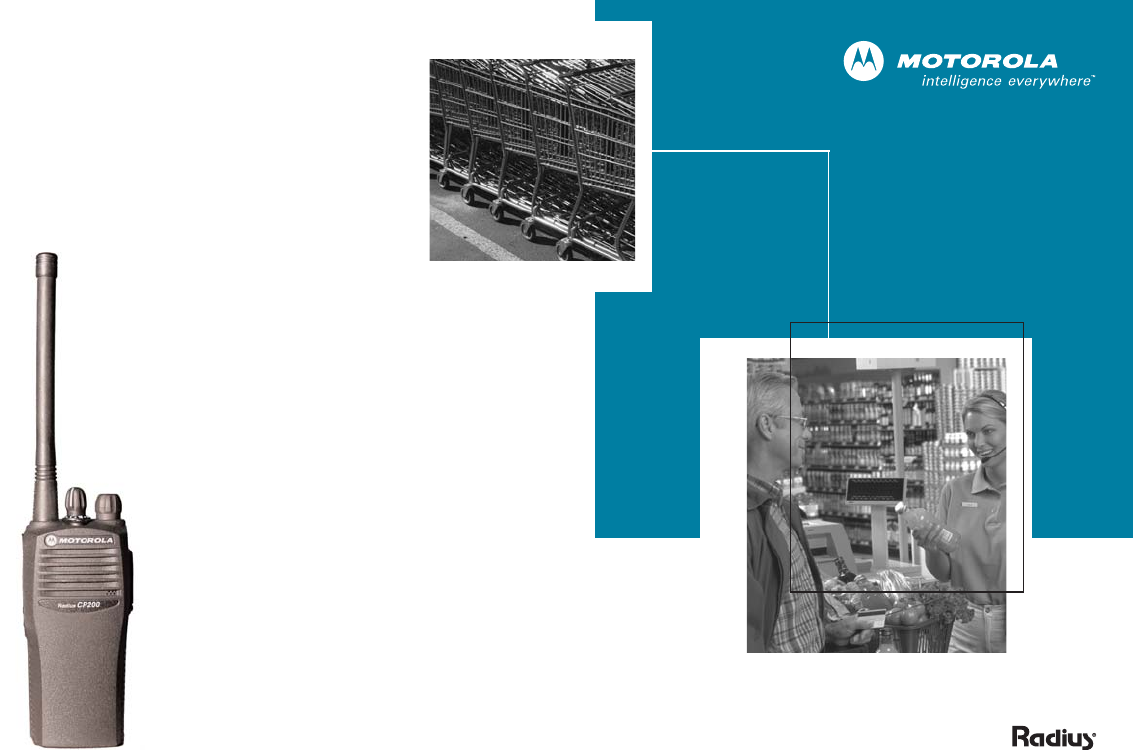
MOTOROLA, the Stylized M Logo, and Radius are registered in the US Patent & Trademark Office.
All other product or service names are the property of their respective owners.
© Motorola, Inc. 2002. All rights reserved. Printed in U.S.A.
MOTOROLA, le logotype au M stylisé et Radius sont enregistrés auprès du Bureau des marques et brevets des États-Unis.
Tous les autres noms de produits et de services sont la propriété de leurs titulaires respectifs.
© Motorola, Inc. 2002. Tous droits réservés. Imprimé aux États-Unis.
*6880309N60*
6880309N60-O
CP150™/CP200™
Commercial Series
Two-Way Radio User Guide
Manuel de l'utilisateur
de la radio bidirectionnelle
309N60-O_cvr.qxd 1/9/2003 11:12 AM Page 1

1
English
CONTENTS
CONTENTS
Computer Software Copyrights . . . . . . . . . . 2
Safety and Warranty . . . . . . . . . . . . . . . . . 3
Product Safety and RF Exposure
Compliance. . . . . . . . . . . . . . . . . . . . . . . . 3
Battery Information . . . . . . . . . . . . . . . . . . . 3
Charging Batteries . . . . . . . . . . . . . . . . . 3
Limited Warranty . . . . . . . . . . . . . . . . . . . . . 4
Radio Overview . . . . . . . . . . . . . . . . . . . . . 9
Parts of the Radio . . . . . . . . . . . . . . . . . . . . 9
CP150™/CP200™ Models . . . . . . . . . . 9
On/Off/Volume Knob . . . . . . . . . . . . . . 10
Channel Selector Knob . . . . . . . . . . . . 10
Push-to-Talk (PTT) Button . . . . . . . . . . 10
Microphone . . . . . . . . . . . . . . . . . . . . . 10
LED Indicator . . . . . . . . . . . . . . . . . . . . 10
Programmable Buttons . . . . . . . . . . . . 11
Indicator Tones . . . . . . . . . . . . . . . . . . . . . 13
Audio Indicators for Programmable
Buttons . . . . . . . . . . . . . . . . . . . . . . . . . . 14
Improved Audio Features . . . . . . . . . . . . . 14
Companding. . . . . . . . . . . . . . . . . . . . . 14
Getting Started . . . . . . . . . . . . . . . . . . . . 15
Battery Information . . . . . . . . . . . . . . . . . . 15
Charging Your Battery . . . . . . . . . . . . . 15
Wall Charger . . . . . . . . . . . . . . . . . . . . 15
Desktop Charger . . . . . . . . . . . . . . . . . 16
Accessory Information . . . . . . . . . . . . . . . 17
Attaching the Battery . . . . . . . . . . . . . . 17
Removing the Battery . . . . . . . . . . . . . 17
Attaching the Antenna . . . . . . . . . . . . . 18
Removing the Antenna . . . . . . . . . . . . 18
Attaching the Belt Clip . . . . . . . . . . . . . 19
Removing the Belt Clip . . . . . . . . . . . . 19
Turning the Radio On or Off . . . . . . . . . . . 20
Adjusting the Volume . . . . . . . . . . . . . . . . 20
Selecting a Radio Channel . . . . . . . . . . . . 20
Sending a Call . . . . . . . . . . . . . . . . . . . . . 21
Receiving a Call . . . . . . . . . . . . . . . . . . . . 21
Monitoring. . . . . . . . . . . . . . . . . . . . . . . . . 21
VOX Operation . . . . . . . . . . . . . . . . . . . . . 22
Enable/Disable Headset Sidetone . . . . . . 22
VOX Headset. . . . . . . . . . . . . . . . . . . . 22
Non-VOX Headset with In-Line PTT . . 23
Radio Calls . . . . . . . . . . . . . . . . . . . . . . . 25
Repeater or Talkaround Mode . . . . . . . . . 25
Setting Tight or Normal Squelch. . . . . . . . 25
Setting the Power Level . . . . . . . . . . . . . . 25
Receiving a Selective Call . . . . . . . . . . . . 26
Receiving a Call Alert Page . . . . . . . . . . . 26
Non-displayTOC.fm Page 1 Thursday, December 19, 2002 5:08 PM

2
English
CONTENTS
Scan . . . . . . . . . . . . . . . . . . . . . . . . . . . . . 27
Starting or Stopping Scan. . . . . . . . . . . . . 27
Talkback . . . . . . . . . . . . . . . . . . . . . . . . . . 27
Deleting a Nuisance Channel . . . . . . . . . . 27
Restoring a Channel to the Scan List . 28
Prioritizing a Scan List Member . . . . . . . . 28
Accessories . . . . . . . . . . . . . . . . . . . . . . 29
Carry Accessories. . . . . . . . . . . . . . . . . . . 29
Chargers. . . . . . . . . . . . . . . . . . . . . . . . . . 29
Batteries . . . . . . . . . . . . . . . . . . . . . . . . . . 29
Headsets . . . . . . . . . . . . . . . . . . . . . . . . . 29
Surveillance Accessories . . . . . . . . . . . . . 30
Remote Speaker Microphones . . . . . . . . . 31
Antennas . . . . . . . . . . . . . . . . . . . . . . . . . 31
COMPUTER SOFTWARE
COPYRIGHTS
The Motorola products described in this
manual may include copyrighted Motorola
computer programs stored in semiconductor
memories or other media. Laws in the United
States and other countries preserve for
Motorola certain exclusive rights for
copyrighted computer programs including, but
not limited to, the exclusive right to copy or
reproduce in any form the copyrighted
computer program. Accordingly, any
copyrighted Motorola computer programs
contained in the Motorola products described
in this manual may not be copied, reproduced,
modified, reverse-engineered, or distributed in
any manner without the express written
permission of Motorola. Furthermore, the
purchase of Motorola products shall not be
deemed to grant either directly or by
implication, estoppel, or otherwise, any license
under the copyrights, patents or patent
applications of Motorola, except for the normal
non-exclusive license to use that arises by
operation of law in the sale of a product.
Non-displayTOC.fm Page 2 Tuesday, December 17, 2002 2:48 PM

3
English
SAFETY AND
WARRANTY
SAFETY AND WARRANTY
PRODUCT SAFETY AND RF
EXPOSURE COMPLIANCE
ATTENTION!
This radio is restricted to occupational use
only to satisfy FCC RF energy exposure
requirements. Before using this product, read
the RF energy awareness information and
operating instructions in the Product Safety
and RF Exposure booklet enclosed with your
radio (Motorola Publication part number
68P81095C98) to ensure compliance with RF
energy exposure limits.
For a list of Motorola-approved antennas,
batteries, and other accessories, visit the
following web site which lists approved
accessories: http://www.motorola.com/cgiss/
index.shtml.
BATTERY INFORMATION
Charging Batteries
This product is powered by a nickel-cadmium
(NICd) or lithium-ion (Lilon) rechargeable
battery. Charge the battery before use to
ensure optimum capacity and performance.
The battery was designed specifically to be
used with a Motorola charger. Charging in non-
Motorola equipment may lead to battery
damage and void the battery warranty.
Note: When charging a battery attached to a
radio, turn the radio off to ensure a full
charge.
The battery should be at about 77°F (25°C)
(room temperature), whenever possible.
Charging a cold battery (below 50° F [10°C])
may result in leakage of electrolyte and
ultimately in failure of the battery. Charging a
hot battery (above 95°F [35°C]) results in
reduced discharge capacity, affecting the
performance of the radio. Motorola rapid-rate
battery chargers contain a temperature-
sensing circuit to ensure that batteries are
charged within the temperature limits stated
above.
Before using this product, read
the operating instructions for safe
usage contained in the Product
Safety and RF Exposure booklet
enclosed with your radio.
!
C a u t i o n
10_SafetyNA..fm Page 3 Tuesday, December 17, 2002 2:53 PM

4
English
SAFETY AND
WARRANTY
LIMITED WARRANTY
MOTOROLA COMMUNICATION
PRODUCTS
I. WHAT THIS WARRANTY COVERS AND
FOR HOW LONG:
MOTOROLA INC. (“MOTOROLA”) warrants the
MOTOROLA manufactured Communication
Products listed below (“Product”) against defects
in material and workmanship under normal use
and service for a period of time from the date of
purchase as scheduled below:
CP150/CP200 Portable Units Two (2) Years
Product Accessories One (1) Year
Motorola, at its option, will at no charge either
repair the Product (with new or reconditioned
parts), replace it (with a new or reconditioned
Product), or refund the purchase price of the
Product during the warranty period provided it is
returned in accordance with the terms of this
warranty. Replaced parts or boards are
warranted for the balance of the original
applicable warranty period. All replaced parts of
Product shall become the property of
MOTOROLA.
This express limited warranty is extended by
MOTOROLA to the original end user purchaser
only and is not assignable or transferable to any
other party. This is the complete warranty for the
Product manufactured by MOTOROLA.
MOTOROLA assumes no obligations or liability
for additions or modifications to this warranty
unless made in writing and signed by an officer
of MOTOROLA. Unless made in a separate
agreement between MOTOROLA and the
original end user purchaser, MOTOROLA does
not warrant the installation, maintenance or
service of the Product.
MOTOROLA cannot be responsible in any way
for any ancillary equipment not furnished by
MOTOROLA which is attached to or used in
connection with the Product, or for operation of
the Product with any ancillary equipment, and all
such equipment is expressly excluded from this
warranty. Because each system which may use
the Product is unique, MOTOROLA disclaims
liability for range, coverage, or operation of the
system as a whole under this warranty.
10_SafetyNA..fm Page 4 Thursday, December 19, 2002 5:05 PM

5
English
SAFETY AND
WARRANTY
II. GENERAL PROVISIONS:
This warranty sets forth the full extent of
MOTOROLA's responsibilities regarding the
Product. Repair, replacement or refund of the
purchase price, at MOTOROLA’s option, is the
exclusive remedy. THIS WARRANTY IS GIVEN
IN LIEU OF ALL OTHER EXPRESS
WARRANTIES. IMPLIED WARRANTIES,
INCLUDING WITHOUT LIMITATION, IMPLIED
WARRANTIES OF MERCHANTABILITY AND
FITNESS FOR A PARTICULAR PURPOSE,
ARE LIMITED TO THE DURATION OF THIS
LIMITED WARRANTY. IN NO EVENT SHALL
MOTOROLA BE LIABLE FOR DAMAGES IN
EXCESS OF THE PURCHASE PRICE OF THE
PRODUCT, FOR ANY LOSS OF USE, LOSS OF
TIME, INCONVENIENCE, COMMERCIAL
LOSS, LOST PROFITS OR SAVINGS OR
OTHER INCIDENTAL, SPECIAL OR
CONSEQUENTIAL DAMAGES ARISING OUT
OF THE USE OR INABILITY TO USE SUCH
PRODUCT, TO THE FULL EXTENT SUCH MAY
BE DISCLAIMED BY LAW.
III. STATE LAW RIGHTS:
SOME STATES DO NOT ALLOW THE
EXCLUSION OR LIMITATION OF INCIDENTAL
OR CONSEQUENTIAL DAMAGES OR
LIMITATION ON HOW LONG AN IMPLIED
WARRANTY LASTS, SO THE ABOVE
LIMITATION OR EXCLUSIONS MAY NOT
APPLY.
This warranty gives specific legal rights, and
there may be other rights which may vary from
state to state.
IV. HOW TO GET WARRANTY SERVICE:
You must provide proof of purchase (bearing the
date of purchase and Product item serial number)
in order to receive warranty service and, also,
deliver or send the Product item, transportation
and insurance prepaid, to an authorized warranty
service location. Warranty service will be
provided by Motorola through one of its
authorized warranty service locations. If you first
contact the company which sold you the Product
(e.g., dealer or communication service provider),
it can facilitate your obtaining warranty service.
You can also call Motorola at 1-800-927-2744
US/Canada.
10_SafetyNA..fm Page 5 Tuesday, December 17, 2002 2:53 PM

6
English
SAFETY AND
WARRANTY
V. WHAT THIS WARRANTY DOES NOT
COVER:
A Defects or damage resulting from use of the
Product in other than its normal and
customary manner.
B Defects or damage from misuse, accident,
water, or neglect.
C Defects or damage from improper testing,
operation, maintenance, installation,
alteration, modification, or adjustment.
D Breakage or damage to antennas unless
caused directly by defects in material
workmanship.
E A Product subjected to unauthorized
Product modifications, disassemblies or
repairs (including, without limitation, the
addition to the Product of non-Motorola
supplied equipment) which adversely affect
performance of the Product or interfere with
Motorola's normal warranty inspection and
testing of the Product to verify any warranty
claim.
F Product which has had the serial number
removed or made illegible.
G Freight costs to the repair depot.
H A Product which, due to illegal or
unauthorized alteration of the software/
firmware in the Product, does not function in
accordance with MOTOROLA’s published
specifications or the FCC type acceptance
labeling in effect for the Product at the time
the Product was initially distributed from
MOTOROLA.
I Scratches or other cosmetic damage to
Product surfaces that does not affect the
operation of the Product.
J Normal and customary wear and tear.
VI. PATENT AND SOFTWARE PROVISIONS:
MOTOROLA will defend, at its own expense, any
suit brought against the end user purchaser to
the extent that it is based on a claim that the
Product or parts infringe a United States patent,
and MOTOROLA will pay those costs and
damages finally awarded against the end user
purchaser in any such suit which are attributable
to any such claim, but such defense and
payments are conditioned on the following:
A that MOTOROLA will be notified promptly in
writing by such purchaser of any notice of
such claim;
10_SafetyNA..fm Page 6 Tuesday, December 17, 2002 2:53 PM

7
English
SAFETY AND
WARRANTY
B that MOTOROLA will have sole control of the
defense of such suit and all negotiations for
its settlement or compromise; and
C should the Product or parts become, or in
MOTOROLA’s opinion be likely to become,
the subject of a claim of infringement of a
United States patent, that such purchaser
will permit MOTOROLA, at its option and
expense, either to procure for such
purchaser the right to continue using the
Product or parts or to replace or modify the
same so that it becomes non-infringing or to
grant such purchaser a credit for the Product
or parts as depreciated and accept its
return. The depreciation will be an equal
amount per year over the lifetime of the
Product or parts as established by
MOTOROLA.
MOTOROLA will have no liability with respect to
any claim of patent infringement which is based
upon the combination of the Product or parts
furnished hereunder with software, apparatus or
devices not furnished by MOTOROLA, nor will
MOTOROLA have any liability for the use of
ancillary equipment or software not furnished by
MOTOROLA which is attached to or used in
connection with the Product. The foregoing
states the entire liability of MOTOROLA with
respect to infringement of patents by the Product
or any parts thereof.
Laws in the United States and other countries
preserve for MOTOROLA certain exclusive rights
for copyrighted MOTOROLA software such as
the exclusive rights to reproduce in copies and
distribute copies of such Motorola software.
MOTOROLA software may be used in only the
Product in which the software was originally
embodied and such software in such Product
may not be replaced, copied, distributed,
modified in any way, or used to produce any
derivative thereof. No other use including,
without limitation, alteration, modification,
reproduction, distribution, or reverse engineering
of such MOTOROLA software or exercise of
rights in such MOTOROLA software is permitted.
No license is granted by implication, estoppel or
otherwise under MOTOROLA patent rights or
copyrights.
VII. GOVERNING LAW:
This Warranty is governed by the laws of the
State of Illinois, USA.
10_SafetyNA..fm Page 7 Tuesday, December 17, 2002 2:53 PM

8
English
SAFETY AND
WARRANTY
Notes:
10_SafetyNA..fm Page 8 Tuesday, December 17, 2002 2:53 PM
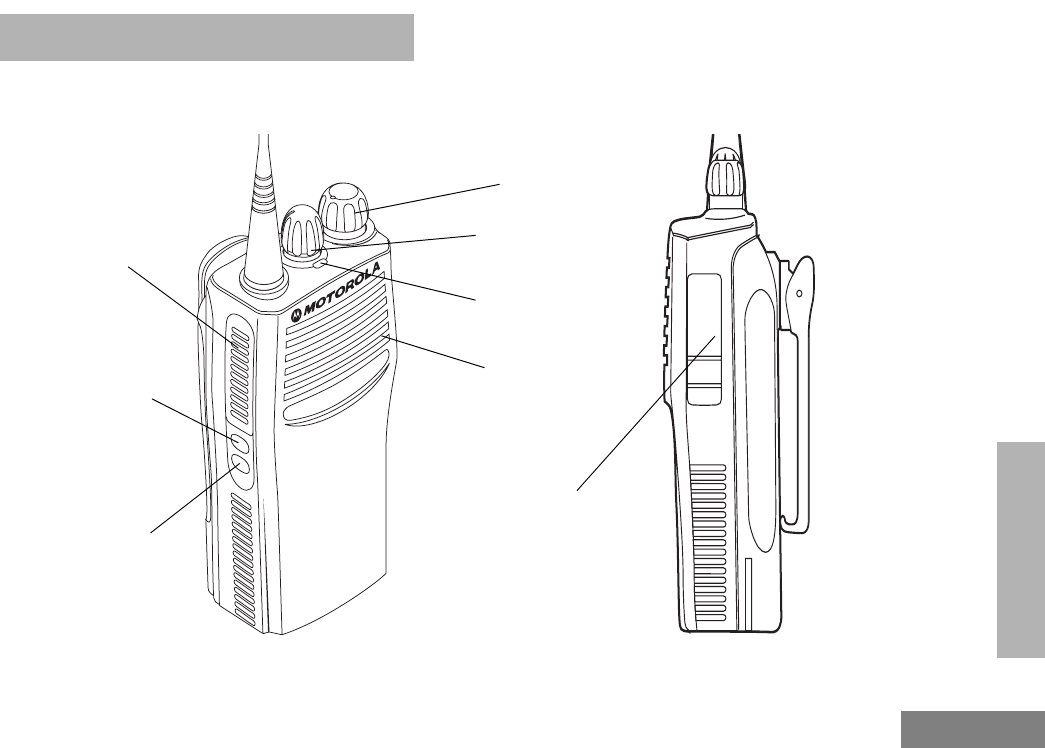
9
English
RADIO OVERVIEW
RADIO OVERVIEW PARTS OF THE RADIO
CP150™/CP200™ Models
(programmable)
Side Button 1
Push-to-Talk
(PTT) Button
(programmable)
Side Button 2 Accessory Connector
with a Dust Cover
LED Indicator
On/Off/Volume
Knob
Channel Selector
Knob
Microphone
03_Overview.fm Page 9 Thursday, December 19, 2002 5:05 PM

10
English
RADIO OVERVIEW
On/Off/Volume Knob
Turns the radio on or off, and adjusts the
radio’s volume.
Channel Selector Knob
Switches the radio to different channels.
Push-to-Talk (PTT) Button
Press and hold down this button to talk
(transmit); release it to listen.
Microphone
When sending a message, hold the
microphone 1 to 2 inches (2.5 to 5 cm) away
from your mouth, and speak clearly into it.
LED Indicator
Indicates power-up, transmit, receive, scan
status, Call Alert™, Selective Call, and battery
status.
Basic Features
LED State/Color Indication
Radio Call
Red Transmitting
Flashing Red Receiving
Scan
Flashing Green Scanning for activity
Call Alert†
Flashing Yellow Indicates receiving a Call Alert
Selective Call†
Flashing Yellow Indicates receiving a Selective
Call
Sticky Monitor/Open Squelch
Yellow While monitoring
Low Battery
Flashing Red
when transmitting Low battery level
†Available for 4W and 5W models only.
03_Overview.fm Page 10 Friday, December 20, 2002 10:55 AM

11
English
RADIO OVERVIEW
Battery Charge Status
You can check battery charge status if your
dealer has preprogrammed one of the
programmable buttons. Hold down the
preprogrammed Battery Indicator button. The
charge status is shown by the color of the
radio’s LED indicator.
Programmable Buttons
The two side buttons on your radio can be
programmed by your dealer as shortcuts to
various radio features.
Check with your dealer for a complete list of
functions your radio supports.
Each button can be programmed to select
features, depending on the type of button
press:
•short press — quickly pressing and releas-
ing the programmable buttons
•long press — pressing and holding the
programmable buttons for a period of time
(default 1 1/2 seconds or programmed
value) before releasing
•hold down — pressing and holding down
the programmable buttons while checking
status or making adjustments
Depending on how your radio has been
programmed by your dealer, these functions
are activated EITHER through a short press
OR a long press, but NOT both.
A summary of programmable radio features
and corresponding page references appears
beginning on page 12.
In the “Feature” column, have your dealer write
down the programmable buttons next to the
features that have been programmed to them.
Battery
Level LED
Indicator
Good Green
Sufficient Yellow
Low Flashing Red
Very Low None
03_Overview.fm Page 11 Tuesday, December 17, 2002 2:22 PM

12
English
RADIO OVERVIEW
Feature Short Press/Long Press Hold Down Page Button
Battery
Indicator — Checks the battery charge status. 11
Sticky
Permanent
Monitor
A long press of the Monitor button
initiates. A short press of the
Monitor button cancels.
Monitors the selected channel for
any activity. 21
Volume Set Sounds a tone for adjusting the radio’s volume level. 20
Voice
Operated
Transmis-
sion (VOX)
Toggle VOX on and off. — 22
Power Level†Toggles your radio’s transmit power
level between High and Low power. —25
Repeater/
Talkaround
Toggles between using a repeater
and transmitting directly to another
radio. —25
Squelch Toggles your radio’s squelch level
between tight and normal squelch. —25
†Available for 4W and 5W models only.
03_Overview.fm Page 12 Tuesday, December 17, 2002 2:22 PM
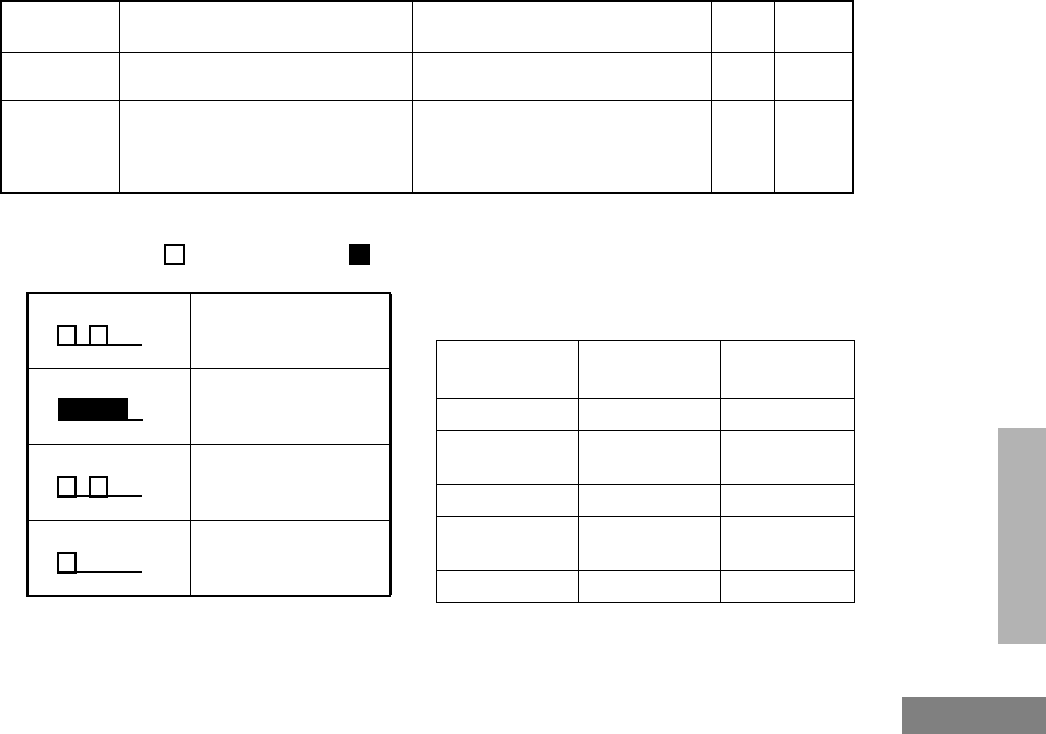
13
English
RADIO OVERVIEW
INDICATOR TONES
High pitched tone Low pitched tone
AUDIO INDICATORS FOR
PROGRAMMABLE BUTTONS
Some programmable buttons use tones to
indicate one of two modes:
Scan Starts or stops the Scan operation. — 27
Nuisance
Channel
Delete
Deletes a nuisance channel while
scanning. —27
Feature Short Press/Long Press Hold Down Page Button
Self Test Pass Tone
Self Test Fail Tone
Positive Indicator Tone
Negative Indicator Tone
Button Positive
Indicator Tone Negative
Indicator Tone
Scan Start scan Stop scan
Power Level†High power
selected Low power
selected
Squelch Tight squelch Normal squelch
Repeater/
Talkaround Does not use
repeater Uses repeater
VOX VOX enabled VOX disabled
†Available for 4W and 5W models only.
03_Overview.fm Page 13 Tuesday, December 17, 2002 2:22 PM

14
English
RADIO OVERVIEW
IMPROVED AUDIO FEATURES
Companding
Companding is a feature that allows further
improvement of voice quality. It compresses
your voice at transmission, and expands it
when receiving while simultaneously reducing
extraneous noise. However, to enjoy this
benefit, all transmitting and receiving radios
must have this feature activated.
03_Overview.fm Page 14 Tuesday, December 17, 2002 2:22 PM

15
English
GETTING STARTED
GETTING STARTED
BATTERY INFORMATION
Charging Your Battery
If a battery is new, or its charge level is very
low, you will need to charge it before you can
use it. When the battery level is low and the
radio is in transmit mode you will see the LED
indicator flash red. Upon release of the PTT
button, you will hear an alert tone.
Note: Batteries are shipped uncharged from
the factory. Always charge a new
battery 14 to 16 hours before initial
use, regardless of the status indicated
by the charger.
Note: Do not use the wall charger and
desktop charger at the same time
when charging.
Wall Charger
Note: Do not use the wall charger if using a
lithium-ion battery. The wall charger is for
nickel-cadmium (NiCd) batteries only.
To Charge the Battery
1Turn the radio off.
2Lift the dust cover to expose the audio
accessory connector.
3Insert the charging adapter into the
accessory connector.
4Plug the charging adapter into an electrical
outlet.
• The LED on the charging adapter lights
Red while the charger is plugged into an
electrical outlet.
Note: Do not leave the charger connected
to the radio when it is not connected
to the electrical outlet.
5Unplug the charger from the electrical outlet
and radio after 10 hours.
Note: After the initial charge of 14 to 16
hours, do not charge the battery
more than 10 hours.
04_GetStarted.fm Page 15 Tuesday, December 17, 2002 2:39 PM
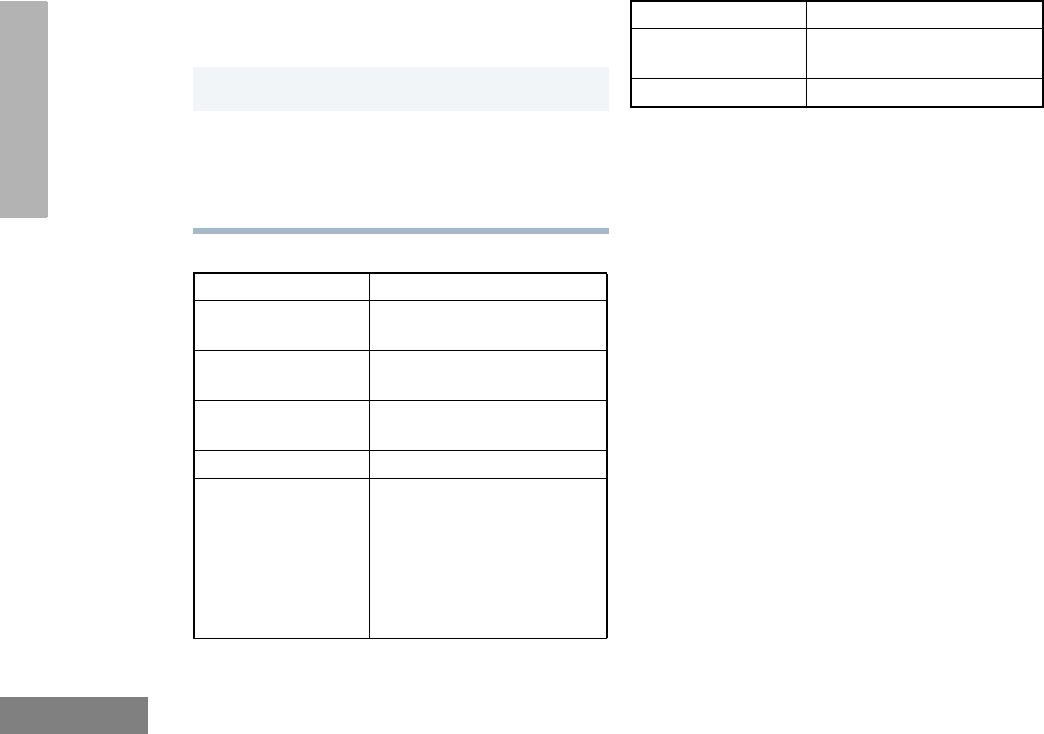
16
English
GETTING STARTED
Desktop Charger
To Charge the Battery
A list of Motorola authorized batteries and
battery chargers appears on page 29. The
listed chargers will charge only Motorola
authorized batteries. Other batteries may not
charge.
1Turn the radio off.
2Place the battery, with or without the radio, in
the charger pocket.
• The charger LED indicates the charging
progress.
LED color Status
No LED Indication Battery inserted incorrectly
or battery not detected.
Single Green Flash Successful charger
power-up.
Flashing Red*Battery unchargeable or not
making proper contact.
Red Battery is charging.
Flashing Yellow Battery in charger but wait-
ing to be charged. The bat-
tery temperature may be too
hot or too cold. The voltage
may be lower than the pre-
determined threshold level
for charging.
Flashing Green†Battery 90% (or more)
charged.
Green Battery fully charged.
* Remove the battery from the charger and use a
pencil eraser to clean the three metal contacts
at the back of the battery. Place the battery
back in the charger. If the LED indicator
continues to flash red, replace the battery.
† A standard battery may require 90 minutes to
charge to 90% capacity.
LED color Status
04_GetStarted.fm Page 16 Tuesday, December 17, 2002 2:39 PM
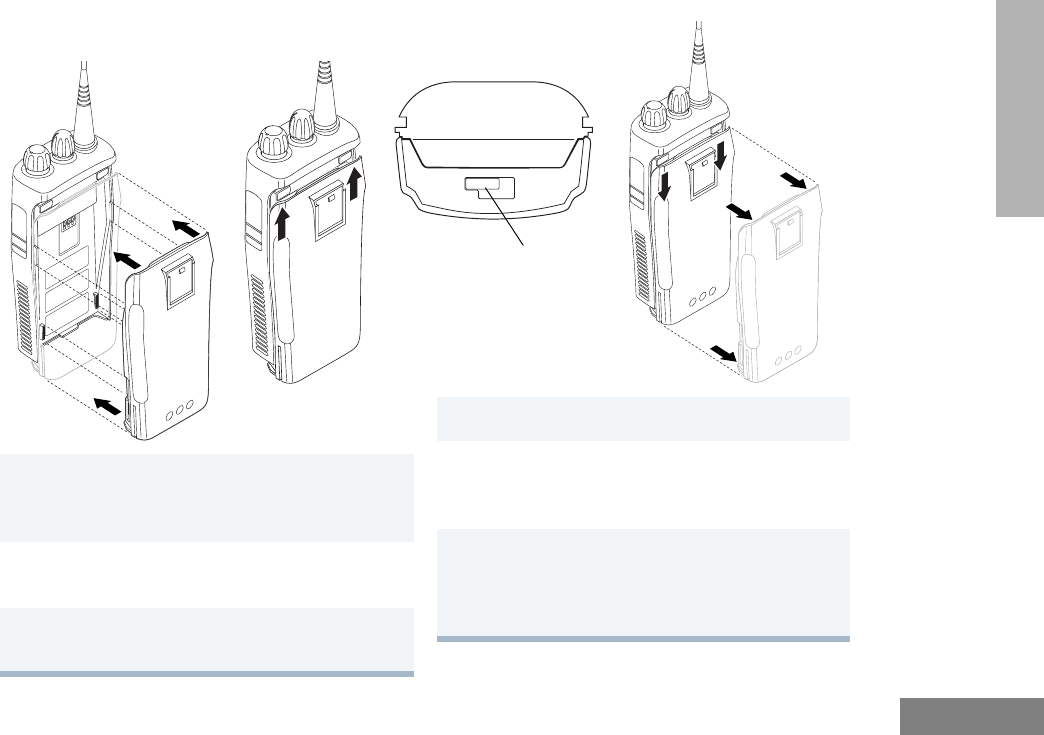
17
English
GETTING STARTED
ACCESSORY INFORMATION
Attaching the Battery
Removing the Battery
1Align the battery to the battery rails on the
back of the radio (approximately 1/2 in. from
the top of the radio.)
2Press the battery firmly to the radio and slide the
battery upward until the latch snaps into place.
3Slide the battery latch, located on radio bottom,
into the lock position.
1Turn off the radio if it is turned on (see page 20).
2Slide the battery latch into the unlock position.
Disengage by pushing downward and holding
the latch towards the front of the radio.
3With the battery latch disengaged, slide the
battery down from the top of the radio about
1/2 in. Once the battery is free from the
battery rails, lift it directly away from the radio.
Battery Latch
04_GetStarted.fm Page 17 Tuesday, December 17, 2002 2:39 PM
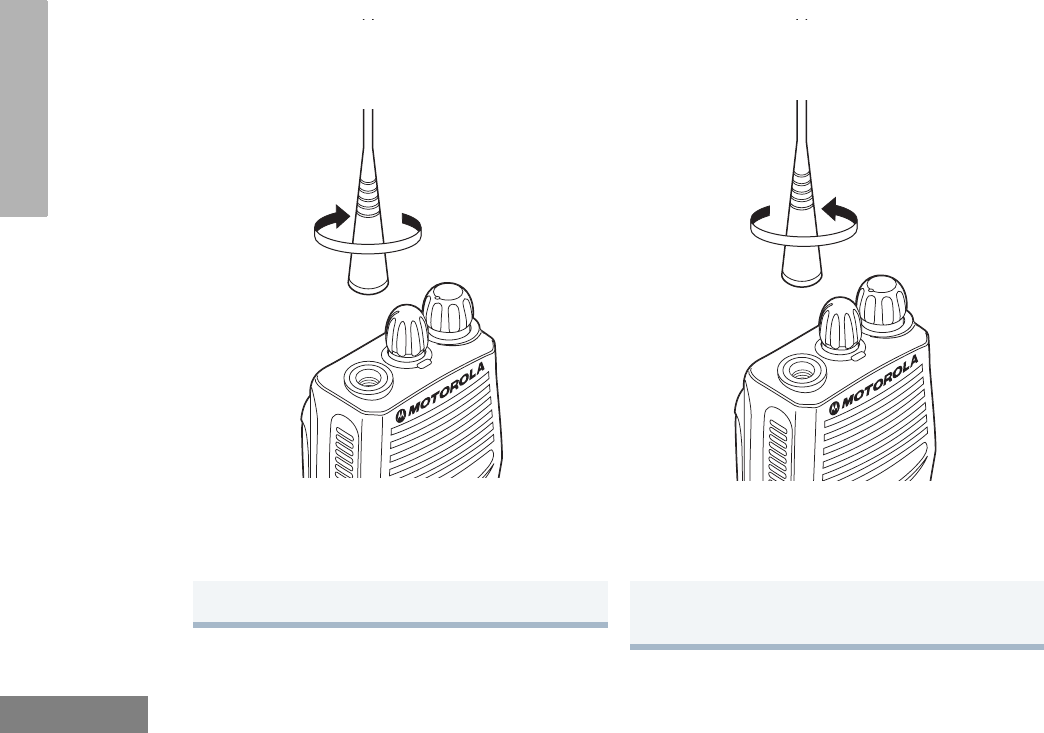
18
English
GETTING STARTED
Attaching the Antenna Removing the Antenna
Turn the antenna clockwise to attach it. Turn the antenna counter-clockwise to remove
it.
04_GetStarted.fm Page 18 Tuesday, December 17, 2002 2:39 PM
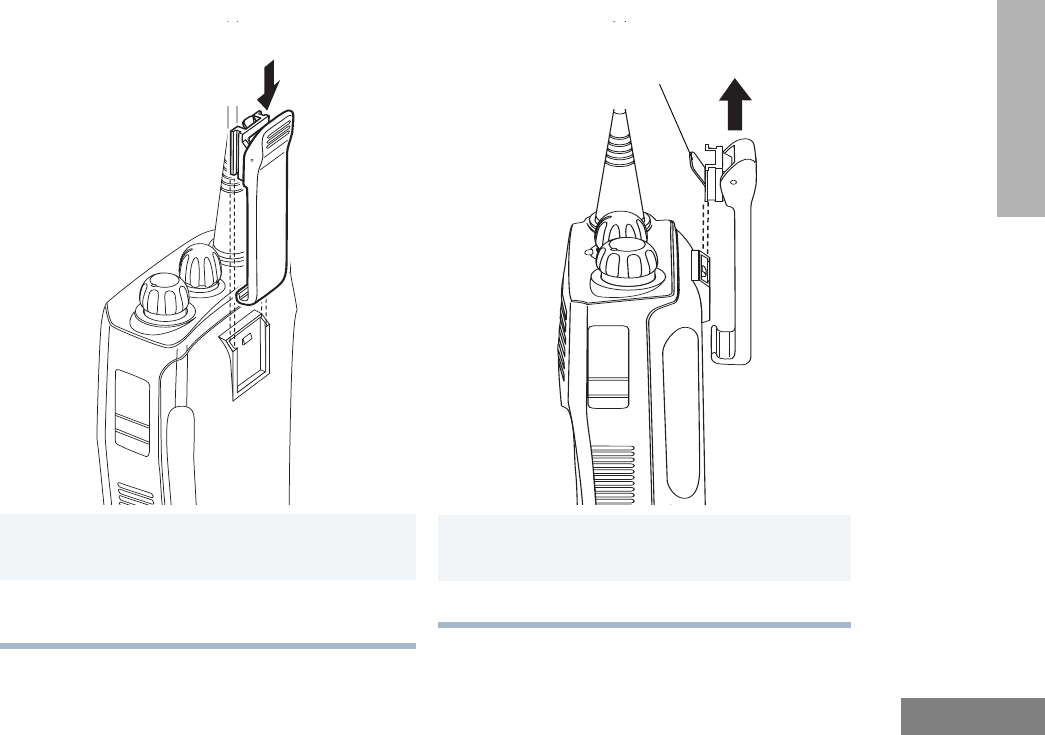
19
English
GETTING STARTED
Attaching the Belt Clip Removing the Belt Clip
1Align the grooves of the belt clip with those of
the battery.
2Press the belt clip downward until you hear a
click.
1Use a key to press the belt clip tab away from
the battery to unlock the belt clip.
2Slide the belt clip upward to remove it.
Belt Clip Tab
04_GetStarted.fm Page 19 Tuesday, December 17, 2002 2:39 PM
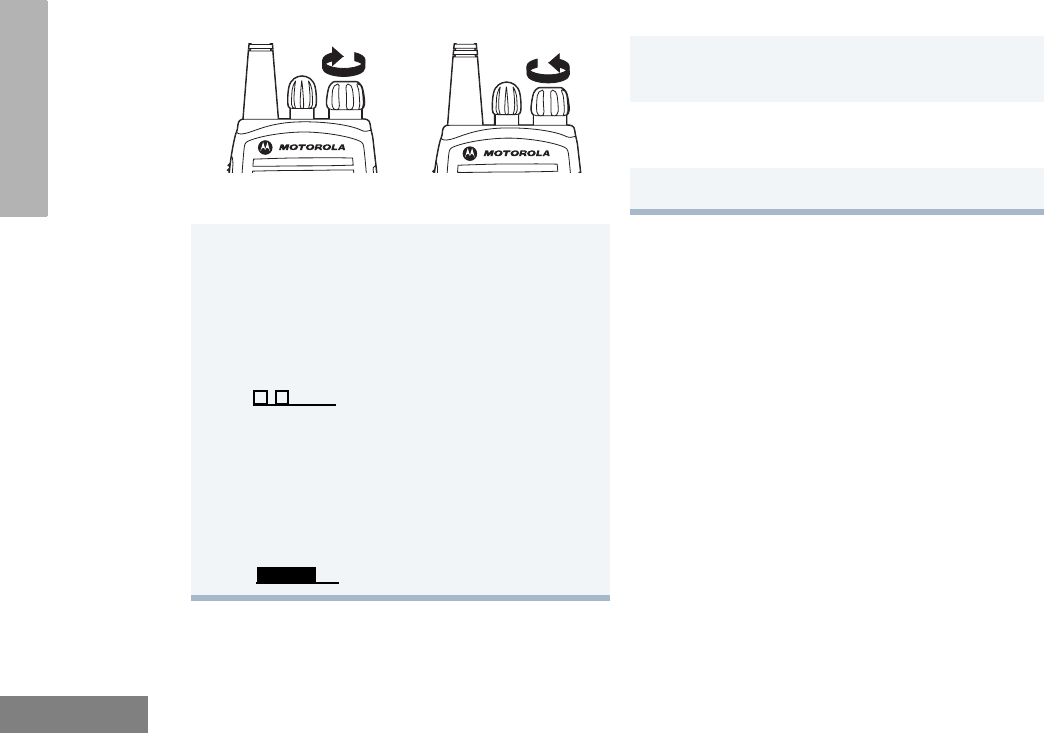
20
English
GETTING STARTED
TURNING THE RADIO ON OR OFF ADJUSTING THE VOLUME
SELECTING A RADIO CHANNEL
Your radio offers 4 or 16 channels.
Note: Due to government regulations, some
channels may not be programmed. Ask
your dealer for more information.
To select a channel, turn the Channel
Selector knob clockwise or counterclockwise
until you reach the desired channel.
Turn the On/Off/
Volume Control
knob clockwise. If
power-up is
successful, you will
hear the Self-Test
Pass Tone
( ) and
see the LED flash
green.
If the radio fails to
power up, you will
hear the Self Test
Fail Tone
().
Turn the On/Off/
Volume Control knob
counter-clockwise until
you hear a click.
ON OFF
1Hold down the Volume Set button (see page
12); you will hear a continuous tone.
2Turn the On/Off/Volume Control knob to the
desired volume level.
3Release the Volume Set button.
04_GetStarted.fm Page 20 Tuesday, December 17, 2002 2:39 PM

21
English
GETTING STARTED
SENDING A CALL
RECEIVING A CALL
MONITORING
It is important to monitor traffic before
transmitting to ensure that you do not “talk
over” someone who is already transmitting.
1Turn your radio on.
2Use the Channel Selector knob to select the
desired channel.
3Hold the radio in a vertical position, press the
PTT, and talk at a distance of about 1 to 2
inches (2.5 to 5 cm) from the microphone.
4Release the PTT to listen.
1Turn your radio on.
2Adjust the radio’s volume (see page 20).
3Switch to the desired channel. To respond,
hold the radio in a vertical position, press the
PTT, and talk at a distance of about 1 to 2
inches (2.5 to 5 cm) from the microphone.
1Press and hold the preprogrammed
Monitor button to access channel traffic.
2Once channel traffic has cleared, proceed
with your call by pressing the PTT button.
3A long press of the preprogrammed Monitor
button places the radio in Sticky Permanent
Monitor mode.
• You hear a high-pitched tone.
A short press of the Monitor button cancels
Sticky Permanent Monitor mode and returns
the radio to normal operation.
04_GetStarted.fm Page 21 Tuesday, December 17, 2002 2:39 PM

22
English
GETTING STARTED
VOX OPERATION
When hands-free operation is desired, your
radio can be activated by voice alone using the
VOX feature when you speak through an
accessory that is connected to your radio.
Connecting a VOX Headset
ENABLE/DISABLE HEADSET
SIDETONE
Your dealer can program your radio to hear
your voice through the headset during transmit.
VOX Headset
1Turn off your radio.
2Connect the VOX accessory to your radio and
turn the radio on.
3To enable or disable VOX operation, press the
preprogrammed VOX button (see page 12).
Note: Pressing the PTT button disables
VOX.
–or–
Select a channel that has been
preprogrammed by your dealer to enable
VOX.
Note: You do not need to press a prepro-
grammed VOX button.
Note: Pressing the PTT button disables
VOX.
4Select a channel that has not been
preprogrammed by your dealer to disable
VOX.
1Turn off your radio.
2Connect the VOX accessory to your radio.
3Turn the radio on. During transmit, the
sidetone will be enabled, if programmed in
the radio.
04_GetStarted.fm Page 22 Tuesday, December 17, 2002 2:39 PM

23
English
GETTING STARTED
Non-VOX Headset with In-Line PTT
1Turn off your radio.
2Connect the non-VOX accessory to your
radio.
3Press and hold the In-line PTT on your
headset.
4Turn the radio on and release the PTT once
the radio has completed start-up.
5To disable the headset sidetone, turn off your
radio and turn the radio on again.
04_GetStarted.fm Page 23 Tuesday, December 17, 2002 2:39 PM

24
English
GETTING STARTED
Notes:
04_GetStarted.fm Page 24 Tuesday, December 17, 2002 2:39 PM

25
English
RADIO CALLS
RADIO CALLS
REPEATER OR TALKAROUND
MODE
Talkaround Mode enables you to communicate
with another radio when either:
• the repeater is not operating
—or—
• your radio is out of the repeater’s range but
within communicating distance of another
radio.
Press the preprogrammed Repeater/
Talkaround button (see page 12) to toggle
between Repeater mode and Talkaround
Mode.
SETTING TIGHT OR NORMAL
SQUELCH
Use this feature to filter out nuisance
(unwanted) calls and/or background noise.
However, tightening squelch could cause calls
from remote locations to be filtered out as well.
In this case, normal squelch may be more
desirable.
Press the preprogrammed Squelch button
(see page 12) to toggle between tight and
normal squelch.
SETTING THE POWER LEVEL
(Available for 4W and 5W models only)
Each channel in your radio has a predefined
transmit power level that can be changed.
•High power allows you to reach a radio that
is farther away.
•Low power conserves the battery’s charge.
Press the preprogrammed Power Level button
(see page 12) to toggle between low and high
power.
05_RadioCall.fm Page 25 Tuesday, December 17, 2002 2:40 PM

26
English
RADIO CALLS
RECEIVING A SELECTIVE CALL
(Available for 4W and 5W models only)
When you receive a selective call:
• The LED indicator flashes yellow, if pro-
grammed by your dealer.
• You hear two high pitched tones.
To answer the call, press the PTT button.
RECEIVING A CALL ALERT PAGE
(Available for 4W and 5W models only)
When you receive a Call Alert page:
• The LED indicator flashes yellow, if pro-
grammed by your dealer.
• You hear four high pitched tones.
To answer the page, press the PTT button; to
cancel the page, press any other key.
05_RadioCall.fm Page 26 Friday, December 20, 2002 10:55 AM

27
English
SCAN
SCAN
You can monitor multiple channels and receive
any calls that are transmitted on them.
Channels can be programmed into a scan list
by your dealer. Your radio automatically
switches to a scan list channel when it detects
activity on it.
STARTING OR STOPPING SCAN
The LED indicator blinks green during a scan
operation and stops blinking when the radio
switches to a channel.
You can start or stop a scan operation by:
TALKBACK
If the Talkback option is preprogrammed, you
can respond to any calls received during the
scan operation. To respond, press the PTT
button before the programmed hangtime
elapses. Otherwise, the radio will continue
scanning. Check with your dealer for details.
DELETING A NUISANCE CHANNEL
Note: Your dealer must have preprogrammed
a button to Nuisance Delete (see page
12) to access this feature.
If a channel continually generates unwanted
calls or noise (a “nuisance” channel), you can
temporarily remove it from the scan list:
1To start or stop a scan operation, press the
preprogrammed Scan button (see page 12).
- or -
2Select a channel that has been
preprogrammed by your dealer to start Auto
Scan.
Note: You do not need to press a prepro-
grammed Scan button.
3Select a channel that has not been
preprogrammed by your dealer to stop Auto
Scan.
1While the radio is on the Nuisance Channel,
press the preprogrammed Nuisance
Channel Delete button until you hear a tone.
2Release the Nuisance Channel Delete
button. The nuisance channel is deleted.
06_Scan.fm Page 27 Tuesday, December 17, 2002 2:40 PM
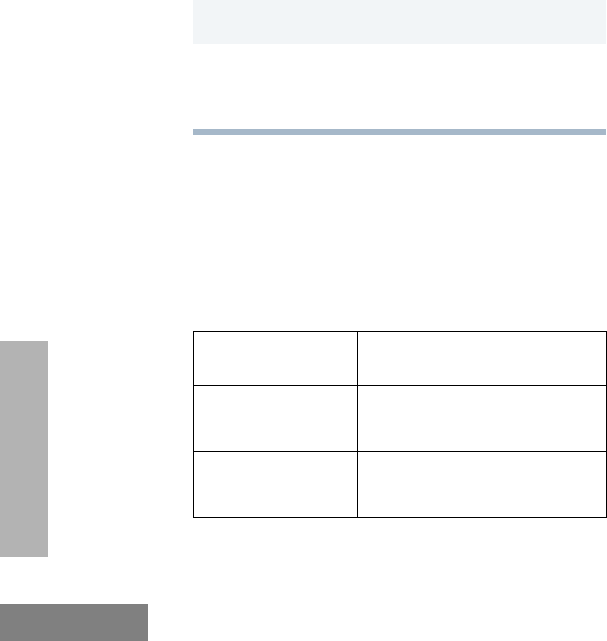
28
English
SCAN
Note: You cannot delete a priority channel or
last remaining channel in the scan list.
Restoring a Channel to the Scan List
PRIORITIZING A SCAN LIST
MEMBER
You may want your radio to scan a specific
channel more frequently for calls. Your dealer
can prioritize scan list members for you. Check
with your dealer for details.
Even though your radio has switched to a non-
priority channel, it will still check for activity on
the priority channel. If activity is detected, the
radio will switch to the priority channel.
1Press the Scan button to stop the scan.
2Press the Scan button again to start scanning
again. The Deleted Nuisance Channel is
restored to the scan list.
Priority Channel Scanning Sequence
None specified Ch1➠Ch2➠Ch3➠
Ch4➠...Ch1
Channel 2Ch2➠Ch1➠Ch2➠Ch3➠
Ch2➠Ch4➠Ch2➠...Ch1
06_Scan.fm Page 28 Tuesday, December 17, 2002 2:40 PM
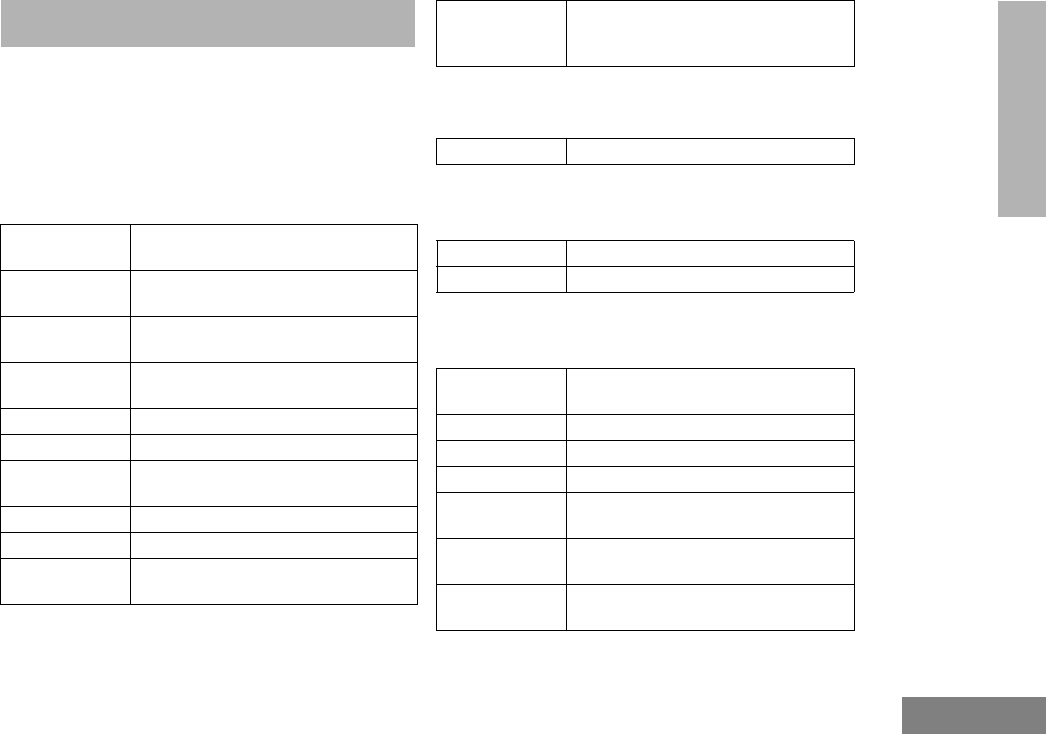
29
English
ACCESSORIES
ACCESSORIES
Motorola offers a number of accessories to
enhance the productivity of your two-way radio.
Many of the available accessories are listed
below.
CARRY ACCESSORIES
CHARGERS
BATTERIES
HEADSETS
HLN9701 Nylon Case with Belt Loop and
D-Shaped Rings
RLN5383 Hard Leather Case with Belt Loop
and D-Shaped Rings
RLN5384 Hard Leather Case with High Activity
2-1/2 inch Swivel Belt Loop
RLN5385 Hard Leather Case with High Activity
3 inch Swivel Belt Loop
HLN8255 3 inch Spring Action Belt Clip
HLN6602 Universal Chest Pack
1505596Z02 Replacement Strap for HLN6602
Universal Chest Pack
RLN4570 Universal Break-A-Way Chest Pack
RLN4815 Universal RadioPak
4280384F89 Replacement Belt Lengthener for
RLN4815 Universal RadioPak
NTN5243 Shoulder Strap for Hard Leather
Cases (attaches to D-Shaped Rings
on case)
WPLN4138 Desktop Charger w/US NA Plug
NNTN4496_R NiCd, 1100 maH
NNTN4497_R Li-Ion, 1800 maH
RLN5411 Ultra-Lite Breeze Behind the Head
Headset
PMMN4001 Ultra-Lite Earset with Mic and PTT
HMN9013 Lightweight Headset w/o In-line PTT
RMN4016 Lightweight Headset with In-line PTT
RLN5238 Lightweight Headset with In-line PTT,
NFL Style
HMN9021 Medium Weight Over the Head Dual
Muff Headset
HMN9022 Medium Weight Behind the Head
Dual Muff Headset
11_Accessory.fm Page 29 Tuesday, December 17, 2002 2:54 PM
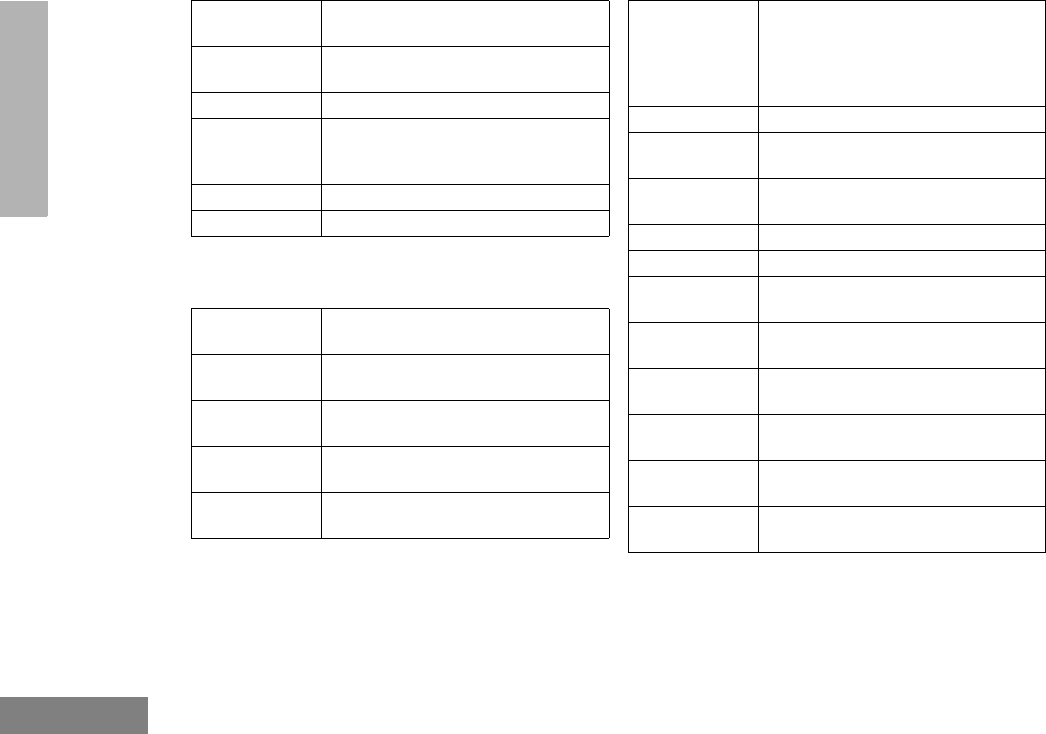
30
English
ACCESSORIES
SURVEILLANCE ACCESSORIES
BDN6647 Medium Weight Single Speaker
Headset
BDN6648 Heavy Duty Dual Muff Headset with
Noise Canceling Microphone
5080371E66 Replacement Ear Pad for BDN6647
RMN5015 Heavy Duty Dual Muff Racing
Headset (requires RKN4090
Headset Adapter Cable)
REX4648 Ear Pad and Windscreen Kit
RKN4090 Adapter Cable for use with RMN5015
HMN9752 Earpiece with Volume Control,
1-Wire (plastic earloop) (Beige)
HMN9727 Earpiece without Volume Control,
1-Wire (plastic earloop) (Beige)
RLN4894 Earpiece without Volume Control,
1-Wire (plastic earloop) (Black)
HMN9754 Earpiece with Microphone & PTT
Combined, 2-Wire (Beige)
RLN4895 Earpiece with Microphone & PTT
Combined, 2-Wire (Black)
RLN5198 Earpiece with Microphone & PTT
Combined (Black) including Low
Noise Kit, 2-Wire Surveillance Kit w/
Clear Comfortable Acoustic Tube
(includes NTN8371)
BDN6720 Flexible Ear Receiver (RX only)
HMN9036 Earbud with Microphone & PTT
Combined, 2-Wire (Black)
HLN9132 Earbud Single Wire Receive Only
(Black)
NTN8370 Extreme Noise Kit
NTN8371 Low Noise Kit
RLN4760 Small Custom Clear Earpiece,
Right Ear
RLN4763 Small Custom Clear Earpiece,
Left Ear
RLN4761 Medium Custom Clear Earpiece,
Right Ear
RLN4764 Medium Custom Clear Earpiece,
Left Ear
RLN4762 Large Custom Clear Earpiece,
Right Ear
RLN4765 Large Custom Clear Earpiece,
Left Ear
11_Accessory.fm Page 30 Tuesday, December 17, 2002 2:54 PM
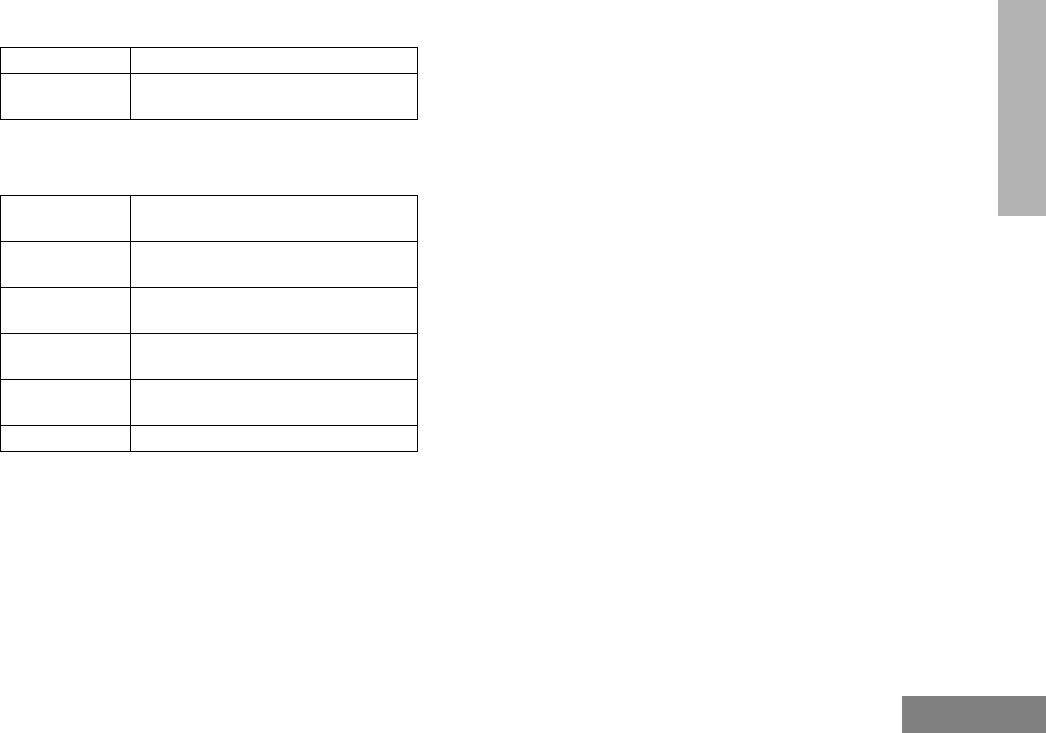
31
English
ACCESSORIES
REMOTE SPEAKER MICROPHONES
ANTENNAS
HMN9030 Remote Speaker Microphone
RLN4904 Mic Jacket for HMN9030 Remote
Speaker Microphone
NAD6502 VHF Heliflex Antenna 14cm,
146-174 MHz
HAD9742 VHF Stubby Antenna, 9cm,
146-162 MHz
HAD9743 VHF Stubby Antenna, 9cm,
162-174 MHz
NAE6522 UHF Heliflex Stubby Antenna 9cm,
438-470 MHz
8505815K26 UHF Heliflex Stubby Antenna 7.1cm,
470-520 MHz
NAE6483 Flexible Whip Antenna, 403-520 MHz
11_Accessory.fm Page 31 Tuesday, August 19, 2003 10:49 AM

32
English
ACCESSORIES
Notes:
11_Accessory.fm Page 32 Tuesday, December 17, 2002 2:54 PM
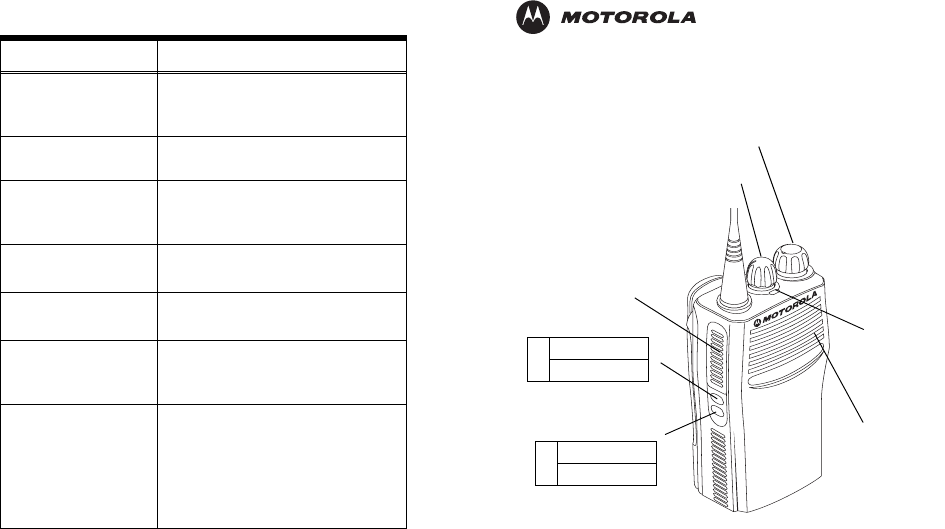
CP150/CP200 Quick Reference Card
NOTE: Enter the functions for your radio’s two
programmable buttons in the boxes provided above.
SP represents Short Press, while LP represents
Long Press.
LED Indicators
LED State/Color Indication
Radio Call
Red
Flashing Red
Transmitting
Receiving
Scan
Flashing Green Scanning for activity
Low Battery
Flashing Red when
sending message
Low battery level
Call Alert†
Flashing Yellow Indicates receiving a Call Alert
Selective Call†
Flashing Yellow
Indicates receiving a Selective
Call
Sticky Monitor/
Open Squelch
Yellow
While monitoring.
Battery Charge
Status
Green
Yellow
Flashing Red
None
Good
Sufficient
Low
Very Low
†Available for 4W and 5W models only.
Microphone
PTT
2SP:
LP:
1SP:
LP:
LED
Indicator
Channel Selector Knob
On/Off/Volume Knob
12_QR-Card.fm Page 33 Friday, December 20, 2002 10:56 AM

Turning On the Radio
• Turn On/Off/Volume Control knob clockwise. If the
radio successfully powers up, you will hear the Self
Test Pass tone and see the LED light green. If the
radio fails to power up, you will hear the Self Test
Fail tone.
Turning Off the Radio
• Turn On/Off/Volume Control knob counter-
clockwise until you hear a click.
Adjusting the Radio Volume
1. Press and hold Volume Set button (preprogrammed
by your dealer) until you hear a continuous tone.
2. Turn On/Off/Volume Control knob to adjust volume
level.
3. Release Volume Set button at desired volume level.
Selecting a Radio Channel
• Turn Channel Selector knob clockwise or counter-
clockwise to reach desired channel.
Sending a Call
1. With radio on, turn Channel Selector knob to
required channel.
2. Press PTT and speak clearly with mouth about 2.5
to 5 cm (1 to 2 inches) away from microphone.
3. Release PTT when call is completed.
Receiving a Call
1. Turn on the radio.
2. Adjust the volume level.
3. Select the radio channel.
Audio Indicators for Programmable Buttons
Starting or Stopping Scan
1. Press the preprogrammed Scan button to start scan.
The LED indictor blinks green during scan operation.
Or, select a channel that has been preprogrammed
to start Auto Scan.
2. Press the Scan button again to stop scan. Or, select
a channel that has not been preprogrammed to stop
Auto Scan.
Deleting a Nuisance Channel
1. With radio on a Nuisance Channel, press and hold
the preprogrammed Nuisance Delete button until
you hear a tone.
2. Release the Nuisance Delete button.
Programmable
Buttons
Positive
Indicator
Tone
Negative
Indicator
Tone
Scan Start Scan
operation Stop Scan
operation
Power Level†Radio transmits
at high power Radio transmits
at low power
Squelch Radio operates
in tight squelch
Radio operates
in normal
squelch
Repeater/
Talkaround
Radio DOES
NOT use the
repeater
Radio uses the
repeater
VOX VOX enabled VOX disabled
†Available for 4W and 5W models only.
12_QR-Card.fm Page 34 Tuesday, December 17, 2002 2:21 PM

MOTOROLA, the Stylized M Logo, and Radius are registered in the US Patent & Trademark Office.
All other product or service names are the property of their respective owners.
© Motorola, Inc. 2002, 2003. All rights reserved. Printed in U.S.A.
MOTOROLA, le logotype au M stylisé et Radius sont enregistrés auprès du Bureau des marques et brevets des États-Unis.
Tous les autres noms de produits et de services sont la propriété de leurs titulaires respectifs.
© Motorola, Inc. 2002, 2003. Tous droits réservés. Imprimé aux États-Unis.
*6880309N60*
6880309N60-A
CP150™/CP200™
Commercial Series
Two-Way Radio User Guide
Manuel de l'utilisateur
de la radio bidirectionnelle
309N60-A_cvr.qxd 8/19/2003 10:43 AM Page 1